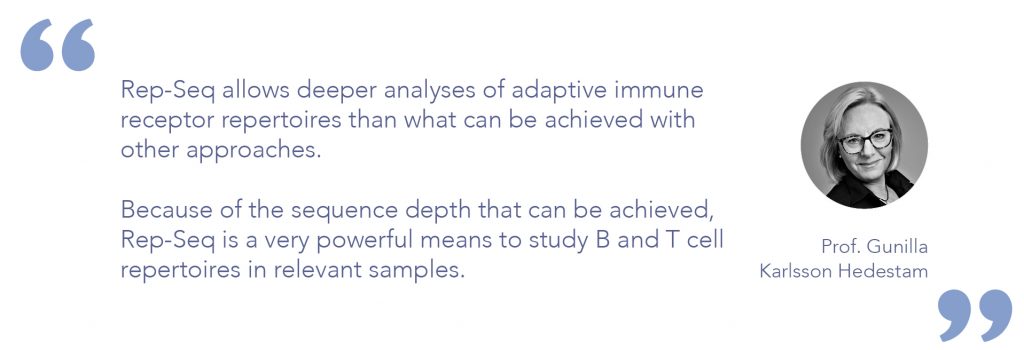Next-Generation Sequencing (NGS) of BCR repertoires plays an increasingly important role in antibody discovery workflows and vaccine studies. By integrating NGS with experimental data, researchers can analyze immune responses induced by candidate vaccines in greater detail than ever before. We spoke with Prof. Gunilla Karlsson Hedestam from the Department of Microbiology, Tumor and Cell Biology (MTC) at the Karolinska Institute in Sweden, about the impact of high-throughput immune repertoire sequencing (Rep-Seq) on antibody and vaccine discovery.
Prof. Karlsson Hedestam’s research focuses on B cell immunology and the capacity of B cells to produce antibodies with highly diverse specificities. Her group applies NGS to analyze expressed immune repertoires to follow the evolution of antigen-specific antibody lineages and to profile immunoglobulin germline genes at a personalized level. Prof. Karlsson Hedestam is a member of the Nobel Assembly since 2016 and a member of the Nobel Committee for Physiology or Medicine since 2019.
How do you think Repertoire Sequencing (Rep-Seq) is changing vaccine and antibody (Ab) discovery?
Rep-Seq allows deeper analyses of adaptive immune receptor repertoires than what can be achieved with other approaches. Because of the sequence depth that can be achieved, Rep-Seq is a very powerful means to study B and T cell repertoires in relevant samples. Rep-Seq is currently one of the most important techniques in the field. It might sound somewhat hyperbolic but having access to Rep-seq data is a bit like being blind and suddenly seeing.
Photo credit: Erik Flyg
What are the main challenges to start using Rep-Seq analysis?
The most common limitation is probably when researchers try to work from libraries that are either too small or not diverse enough. The starting material is critical. If the library is too small or biased in terms of sequence representation, then the downstream analyses will suffer. You will not get accurate repertoire metrics including underestimating clonal diversity.
Another current limitation is the lack of good databases for germline gene assignment. If VDJ sequence assignments are incorrect, then all subsequent downstream analyses will be affected. By not having the right databases, you are going to miss a lot of information in your assignment and therefore misinterpret results. In the case of humans, the generation of a comprehensive germline reference databases is within reach. We are working on this task and it requires in-depth, careful analyses of samples from multiple donors from different parts of the world combined with the use of several complementary methods and thorough validation techniques.
What insights can we draw from Ab lineage analysis in vaccine and monoclonal antibody (mAb) development?
Many insights, for example how the B cell response develops to a given antigen, how different clonal lineages expand or contract, and if they acquire somatic hypermutations, suggestive of affinity maturation. Adaptive immune responses are highly complex and monoclonal antibody isolation efforts or lower throughput single B cell analyses only provide a tip of the iceberg. By combining mAb isolation with Rep-Seq and lineage studies, it is possible to identify somatic variants, allowing the generation of large family trees for each antibody. From such trees, variants of interest can be selected for expression and functional analyses, allowing the identification of antibodies with improved properties like more potent neutralization of viral targets. If applied correctly, such studies allow investigations of how vaccine-induced B cell responses mature. Moreover, lineage tracing can provide information about biological properties of the response, such as whether a given lineage can be found in long-lived B cell compartment and thus, contribute to long-lived memory.
Can you elaborate on the importance of potent responses in a long-lived compartment in vaccination?
The whole point with vaccines is that they should provide long-term protection. In general, if you know that your response has been seeded into the long-lived bone marrow compartment then cells can persist for decades, which is a desired property for a vaccine. Typically, studies performed in animals are not extended for long enough periods (e.g., 10 years) to measure the long-term response. This makes the presence of B cells expressing neutralizing antibodies in long-lived compartments an interesting metric to predict a durable response.
What sequence characteristics does a potent antibody response have?
With sequencing alone, it is very challenging to predict specificity and potency unless you have a class defined. However, there are certain characteristics to look for: public clonotypes, for example, are interesting for finding potentially interesting antibodies from sequencing information alone. For COVID-19, many so-called class 1 neutralizing antibodies, which bind the receptor-binding domain of the SARS-CoV-2 spike, use IGHV3-53 and have a short HCDR3. These characteristics indicate potential lineages of interest. There is no guarantee that such antibodies will have potent neutralizing activity, but such signatures allow the selection of potentially interesting antibodies.
In HIV-1, there is a focus on studying SHM levels of elicited Ab elicited. What is the main reason for this and how do you use that measure?
HIV-1 is an unusually challenging target since it is a virus that establishes chronic infection. This means that it has evolved highly effective means to evade recognition by neutralizing antibodies, such as a dense glycan shield and conformational masking of conserved epitopes. Studies of broadly neutralizing antibodies (bNAbs) from infected persons have shown that such antibodies often require extensive SHM to acquire potent neutralizing properties. This, and many years of work in the HIV vaccine field, have demonstrated the challenge of eliciting bNAbs through vaccination. It is therefore important to apply approaches that allow the evaluation of SHM of polyclonal antibody responses in vaccination studies, as we did in our study in JEM 2020 (Phad et al).
Is antigen binding sufficient for Ab therapeutics or can high SHM be an indicator of some clinically favorable effect?
For therapeutic mAbs, what ultimately matters, is how well the Ab binds its target and that the desired effect is achieved in vivo. Each Ab is unique, some antibodies require more SHM than others. In some cases, it is advantageous to back-mutate SHM to the germline configuration for those mutations that are not required for full Ab activity to minimize potential immunogenicity of the Ab. This is a very important aspect for therapeutic antibodies as anti-drug antibody (ADA) responses are commonly observed in patients receiving mAb therapies, which may render the treatment ineffective. Studies of which mutations to keep and which not to keep are therefore important.
Can NGS play a role in the candidates’ mutation analysis?
Before NGS entered the field, companies would only obtain a small list of candidates. If they saw high mutation percentages, they would back-mutate all SHM outside the CDRs to avoid potential immunogenicity issues. Now, they can use NGS to see which mutations might be important. If you have enough clonal variants of a given antibody you can align the sequences and look for mutations that are conserved in most of sequences, suggesting that this mutation is selected for, which is a strong indication of functional importance.
Viral escape is an important research topic to efficiently combat epidemics of infectious diseases. Does affinity and SHM levels play a role in the capacity of the virus to escape an immune response or Ab treatment?
Yes, it likely does as SHM is a result of B cell selection, the B cells with the highest affinity BCRs are selected. Antibodies with high affinities are less dependent on a single mutation in the virus target epitope as an antibody-antigen footprint covers a large area composed of many amino acids that mediate contact. The more contact residues, the more stable the binding (higher affinity) and the less dependent the antibody is on single mutations in the virus target epitope.
What technology do you think is revolutionizing the vaccine and Ab discovery field?
Rep-Seq is indeed one of the most important technologies of recent years. On its own it has its limitations because you cannot derive everything from sequences yet. The algorithms to predict function and binding specificity from sequence information are improving, but there are limits. For now, you still need to express and test the antibodies to have more data to train the AI models.
The other technological revolution I would like to highlight is the rapid increase in functional characterization of antibodies using platforms like yeast display. It allows for a very efficient screening of thousands of expressed mAbs in a short time. This has been applied by academic researchers such as George Georgiou’s group, and companies are also picking it up now.
Rep-Seq and all its applications represent an exciting field of work, which likely will have major impact on clinical medicine in the coming years. We are lucky to be able to contribute to this rapidly moving area of science.
We would like to thank Prof. Gunilla Karlsson Hedestam for sharing her insights with us. Would you like to know how you can expand and improve your antibody candidate pool by integrating high-throughput sequencing data in your antibody discovery workflow?
Watch our latest webinar now or request a live demo!
 | Néstor Vázquez BernatApplication SpecialistAs an Application Specialist at ENPICOM, Néstor focuses on analyzing customer requirements, and project setup, management, and execution. During his PhD in Immunology at the Karlsson Hedestam group at the Karolinska Insitutet in Sweden, he isolated and expressed monoclonal antibodies after vaccinations and developed high-throughput sequencing library preparation protocols for B cell repertoires in humans, non-human primates, and other animal models. |
